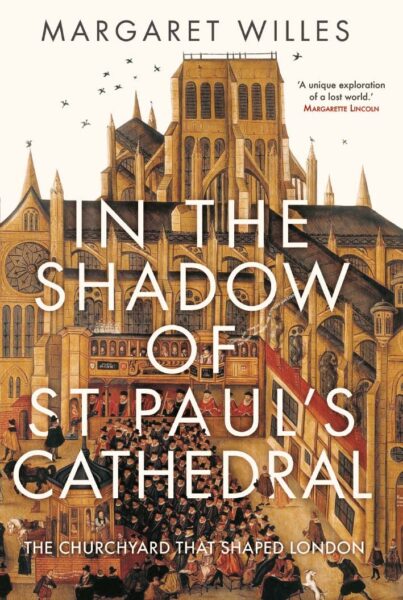St Paul’s Cathedral is almost too famous to write about, as so much has been written already that it would be a struggle to find something new to say. However, while most history books look at the building and the people who worked there, a new book turns its back on the grand edifice and looks at the ramshackle streets and trades that surrounded the cathedral.

The area around St Paul’s was the heart of book publishing in London for centuries, from its early regulations in the time of Queen Mary through to the 19th century when it was slowly supplanted by, as I was surprised to learn, haberdashery.
The book ranges from medieval to modern times and paints a portrait of the many people and trades that grew up around the cathedral, but also the wider political context in which events took place.
Whereas today preachers preach inside churches, even old Medieval St Paul’s wasn’t large enough for the huge crowds that would come to hear the celebrities of the time giving their addresses to the people. And thanks to the growing book trade, often publishing their speeches to be shared more widely.
The book is also rich in details about the less savoury aspects of medieval life, such as the punishment meeted out to women who were accused of adultery, through to the early days of theatre plays in London, and the trade in young boys for the playhouses.
It’s a fascinating look at the history of the area and the many trades that were being carried out by often overlooked people in the surrounds of the cathedral, and while focused on this geographical area, it lets us imagine what life would have been like for any Londoner alive in the centuries being written about.
It’s also a bit of an eye-opener at times, and I certainly took notes for future reading, and one story that I had always assumed was an urban legend turned out to be more truth than myth.
As a book, it can at times be a bit dense, and it helps to have a general understanding of the key historical events in the years it covers. I also found the third quarter or so of the book to be, maybe not entirely necessary, being very much filled with quotes from other books about the booksellers. I’d have put that into an appendix at the end of the book if it had to be included.
I also found the book, particularly the later quarter, tended to jump around dates quite a bit. One minute you’re reading about the 20th century, then a sentence later it’s the 18th century. There were several chronological surprises until I reread the sentence and realised the centuries had changed.
That said, baring the occasional bit of heavy work with the history, it’s a remarkable revelation of an area that I thought I knew as a generalist fairly well. Like all familiar places, the best books are those that take you on a journey around and show off the wrinkles you had never been aware of. This is a warts and all exposé of the people who worked around the Cathedral when it was the heart of London’s business district.
It’s a fascinating read.
The book, In The Shadow of St. Paul’s Cathedral: The Churchyard that Shaped London by Margaret Willes is available from Amazon, Foyles, Waterstones, and good booksellers.
Margaret Willes, formerly publisher at the National Trust, is author of several books, including The Curious World of Samuel Pepys and John Evelyn, Reading Matters, and The Gardens of the British Working Class. She lives in London.






